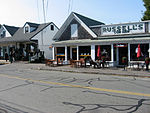Hoxie House
1675 establishments in Plymouth ColonyBuildings and structures in Sandwich, MassachusettsHistoric house museums in MassachusettsHouses completed in 1675Houses in Barnstable County, Massachusetts ... and 2 more
Museums in Barnstable County, MassachusettsSaltbox architecture in Massachusetts

The Hoxie House (c. 1675) is a saltbox house located in Sandwich, Massachusetts. According to the Massachusetts Historical Commission, it is likely the oldest extant house "in the area". The residence was owned by both the Smith and Hoxie families before being turned over to the town of Sandwich in 1959. During this time the house was restored, and it now operates as a museum.
Excerpt from the Wikipedia article Hoxie House (License: CC BY-SA 3.0, Authors, Images).Hoxie House
Water Street,
Geographical coordinates (GPS) Address Nearby Places Show on map
Geographical coordinates (GPS)
| Latitude | Longitude |
|---|---|
| N 41.755338888889 ° | E -70.498194444444 ° |
Address
Hoxie House (The Old Hoxie House)
Water Street 18
02563
Massachusetts, United States
Open on Google Maps







